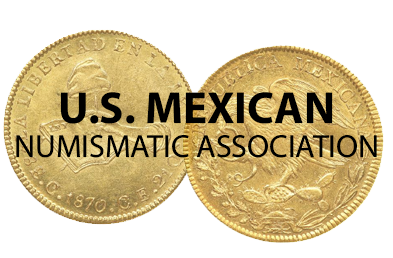Twenty centavos (1905-1984)
These were made in nine basic types
Type 1 - .800
Type 2 – Little .800
Type 3 – Monogram
Type 4 - .720
Type 5 – Pyramid
Type 6 – New Eagle
Type 7 – Restyled Eagle
Type 8 – Madero
Type 9 – Olmec
Type 1 - .800
These were authorised by the Ley Monetaria of 25 March 1905 and the decree of 5 April 1905.
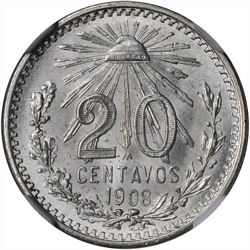
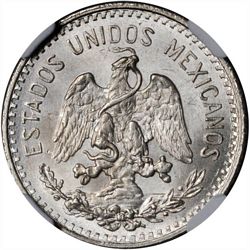
KM-435 1908 20c (Stack’s-Bowers ANA auction, 4 August 2017, lot 21264)
These were composed of 80% silver and 20% copper, had a diameter of 22 mm and weight of 5 g.
| Year | Mintage | |
| 1905 | 2,565,000 | |
| 1906 | 6,860,000 | |
| 1907 | 9,434,699 | In 1907 the New Orleans mint minted 5,434,619 coins, with a curved 7. The rest, with a straight 7, were made in Mexico. |
| 1908 | 350,000 | |
| 1910 | 1,135,000 | |
| 1911 | 1,150,000 | |
| 1912 | 625,000 | |
| 1913 | 1,000,000 | |
| 1914 | 1,500,000 | narrow date, wide date |
Type 2 – Little .800
On 13 November 1918 Venustiano Carranza reduced the silver content of Mexico’s coins. The reason given in his decreeDiario Oficial, 14 November 1918 were that
(a) as a result of the rise in the global price of silver, the pesos fuertes had long since been driven out from circulation, and the functions of the fractional silver coinage had been hindered by their increasing tendency to disappear;
(b) this was due to unavoidable economic causes, and so the government was unable to prevent the disappearance of the fractional coinage. The remedy was, therefore, to reduce the quantity of pure silver contained in the fractional coin in such a way that there was no inducement to export, recast or simply hide This was all the more acceptable as the fractional coinage had only a representative value, as an auxiliary to the gold coins, that were the basis of the monetary system.
(c) that, since the old silver pesos had disappeared from circulation for some time, there was no longer any reason to consider them as part of the monetary system; and that, since it was desirable to fractional coins worth one peso, it was necessary to demonetize the old silver pesos, thus completing and consolidating the monetary regime established on 25 March 1905, through the country's definitive entry into gold monometallism.
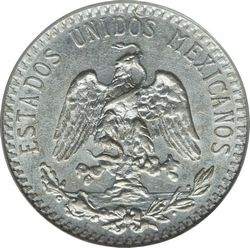
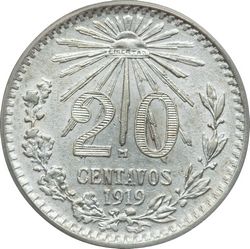
KM-436 1919 20c
These were like Type 1 but 3 mm smaller in diameter. Mintage was 4,155,000 in 1919.
When Plutarco Calles authorised the new 10c coin in 1925, he also decreed that the silver 10c, 20c, 50c and $1 coins created by the 13 November 1918 law should be legal tender up to the end of 1925Diario Oficial, Tomo XXX, Núm. 3, 6 May 1925.
Type 3 – Monogram
On 7 January 1920 Venustiano Carranza authorised a new 20c coin in bronzeDiario Oficial, Tomo XIV, Núm. 10, 12 January 1920
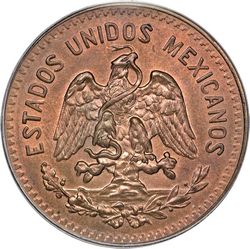
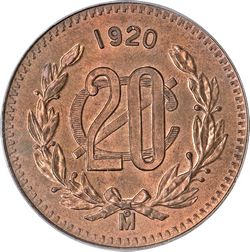
KM-437 1920 20c
These were composed of 95% copper, 2.5% tin and 2.5% zinc, had a diamter of 32.5 mm and weight of 15 g.
Mintage was 4,835,450 in 1920.
When Plutarco Calles authorised the new 10c coin in 1925, he also decreed that the bronze 10c and 20c coins, created by the 27 October 1919 and 7 January 1920 laws respectively, should be legal tender up to the end of 1925Diario Oficial, Tomo XXX, Núm. 3, 6 May 1925.
However in 1935, when the high price of silver caused the disappearance of silver coins, Mexico again produced these bronze coins, with 20,000,000 pieces dated 1935.
Type 4 - .720
On 27 October 1919 Venustiano Carranza noted that the continuing rise in the price of silver threatened the disappearance of the one-peso, fifty-, twenty-, and ten-centavo coins created by the previous year’s law, and that the government needed to ensure a supply of such coinage to maintain daily commercial transactions, and so issued a new decree, altering the composition of the 20c, 50c and $1 coins and introducing a new bronze 10c pieceDiario Oficial, 31 October 1919.
KM-438
These were same as Type 2 but with reduced silver content (72% silver, 28% copper). They had a diameter of 19 mm and a weight of 3.33 g.
| Year | Mintage | |
| 1920 | 3,710,000 | |
| 1921 | 6,160,000 | |
| 1925 | 1,450,000 | |
| 1926 | 1,465,000 | 6 over 5 |
| 1927 | 1,405,000 | |
| 1928 | 3,630,000 | |
| 1930 | 1,000,000 | |
| 1933 | 2,500,000 | |
| 1934 | 2,500,000 | |
| 1935 | 2,460,000 | |
| 1937 | 10,000,000 | |
| 1939 | 8,800,000 | |
| 1940 | 3,000,000 | |
| 1941 | 5,740,000 | |
| 1942 | 12,460,000 | |
| 1943 | 3,955,000 |
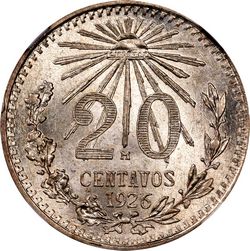
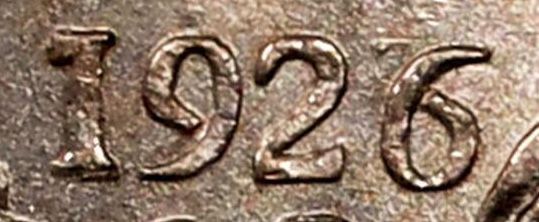
KM-438 1926 20c 6 over 5 (Stack’s-Bowers auction, 17 May 2024, lot 34399)
“The top left corner of the "5" can clearly be seen under minimal magnification”
Type 5 – Pyramid
Because of the hoarding of silver coins, a new 20c coin was introduced in 1943.
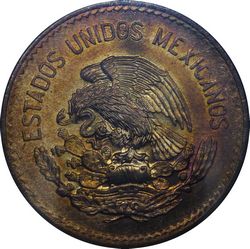
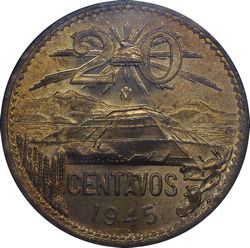
KM-439 1945 20c
The design depicts the Aztec Pyramid of the Sun at Teotihuacán. These had a composition of 95% copper, 4% zinc and 1% tin, a diameter of 28.5 mm and weight of 10 g.
| Year | Mintage | |
| 1943 | 46,350,000 | |
| 1944 | 83,650,000 | |
| 1945 | 26,800,500 | |
| 1946 | 25,695,000 | |
| 1951 | 11,385,000 | |
| 1952 | 6,559,500 | |
| 1953 | 26,947,000 | |
| 1954 | 40,108,000 | |
| 1955 | 16,950,000 | includes mintage of KM-440 |
Type 6 – New Eagle
On 13 September 1955 Adolfo Ruiz Cortines issued a decree giving the characteristics of new coins of 1c, 5c, 10c, 20c, 50c $1, $5 and $10Diario Oficial, 15 September 1955.
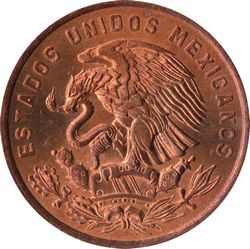
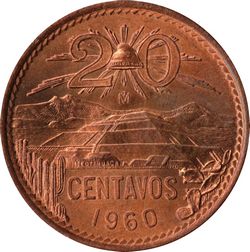
KM-440 1960 20c
This is like Type 5, but with the eagle redesigned to have stylised leaf-like feathers and very large feet.
| Year | Mintage | |
| 1955 | included in mintage of 16,950,000 but probably rarer than KM-439 | |
| 1956 | 22,431,000 | |
| 1957 | 13,455,000 | |
| 1959 | 6,016,500 | |
| 1960 | 39,756,000 | |
| 1963 | 14,869,000 | |
| 1964 | 28,653,500 | |
| 1965 | 74,161,500 | |
| 1966 | 43,744,500 | |
| 1967 | 46,486,500 | |
| 1968 | 15,477,000 | |
| 1969 | 63,646,500 | |
| 1970 | 76,287,000 | |
| 1971 | 49,891,500 | includes mintage of KM-441 |
Type 7 – Restyled Eagle
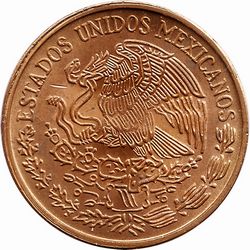
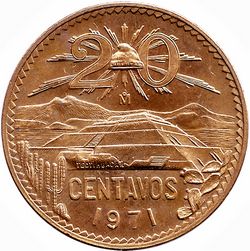
KM-441 1971 20c
This is like Type 6, but with the obverse further redesigned such that all the devices are depicted as raised outlines on a flat surface, rather than fully contoured shapes.
| Year | Mintage | |
| 1971 | included in mintage of 49.891,500 above | |
| 1973 | 78,398,000 | |
| 1974 | 34,200,000 |
Type 8 – Madero
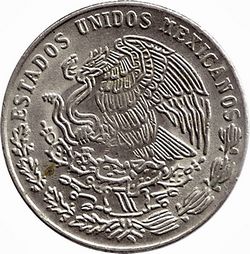
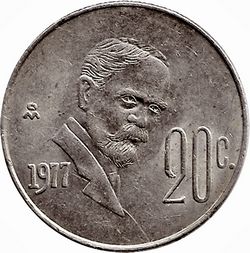
KM-442 1977 20c
These were authorised by a decree of 29 December 1973Diario Oficial, 31 December 1973. They were composed of 75$ copper and 25% nickel, had a diameter of 20 mm and weight of 3 g.
| Year | Mintage | |
| 1974 | 112,000,000 | |
| 1975 | 611,000,000 | |
| 1976 | 394,000,000 | |
| 1977 | 394,350,000 | |
| 1978 | 527,950,000 | |
| 1979 | 4,615,000 | |
| 1980 | 326,500,000 | |
| 1981 | 248,500,000 | 1981/82, closed 8, open 8 |
| 1982 | 286,855,000 | |
| 1983 | 100,930,000 | round top 3, flat top 3 |
Scott Doll's study of this issue can be found here.
Type 9 - Olmec
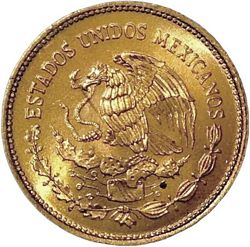
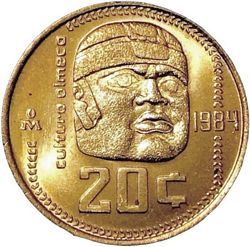
KM-491 1944 20c
These were authorised by José López Portillo in a decree of 21 December 1981Diario Oficial, 28 December 1981. They were composed of 95% copper and 5% zinc, had a diameter of 20 mm and weight of 3.04 g.
Mintage was 200,000,000 in 1983 and 180,320,000 in 1984.
